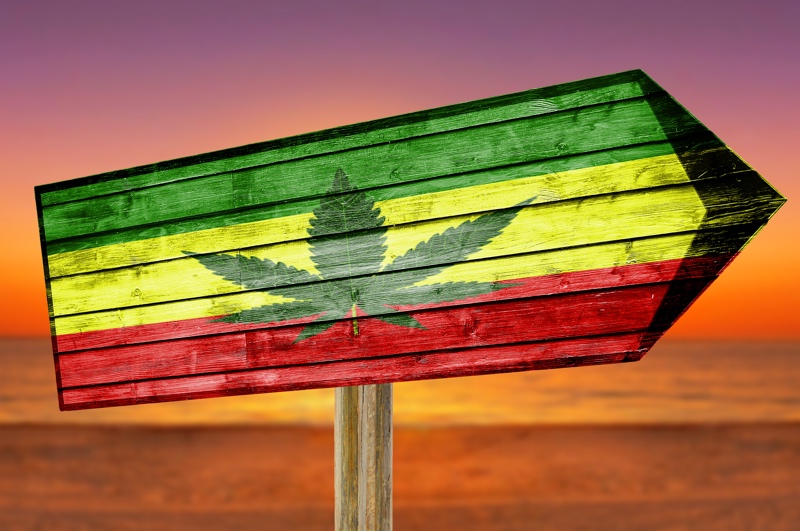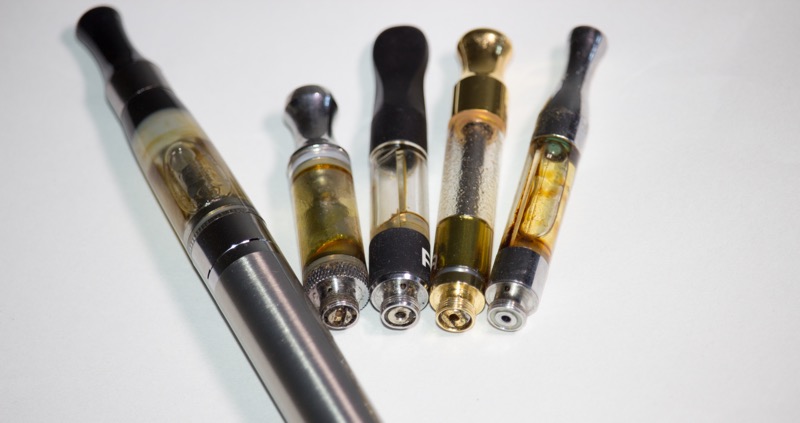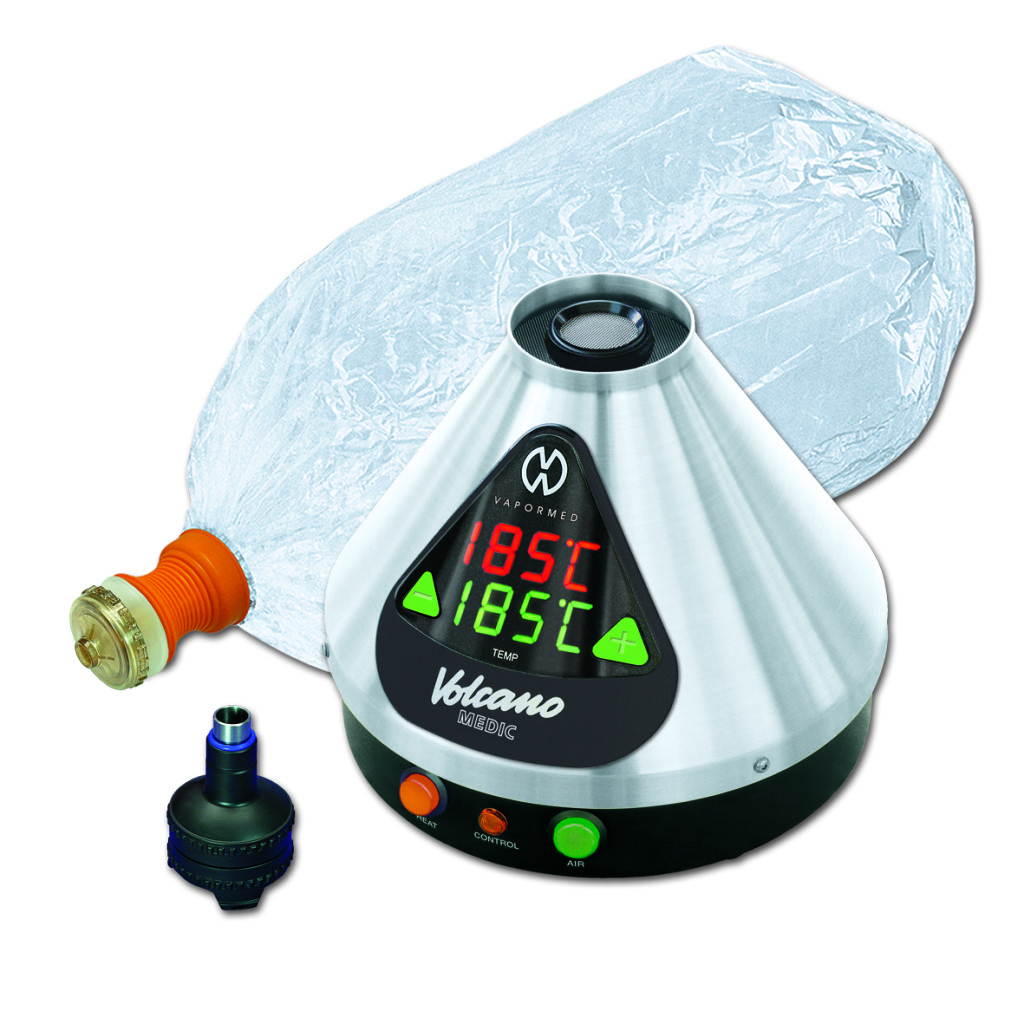CBD Vape Oil: The Complete Beginner’s Guide to Cannabis Oil
14 Comments
The biggest trend in cannabis (well, besides legalization) is vaping concentrated cannabis oil, and it’s obvious why. Vaping marijuana oil is more convenient, discreet, less pungent, easier to do on-the-go, and all-around a more “attractive” way of consuming cannabis than almost any other. Indeed, CBD vape oil is becoming equally, if not more so, all the rage among cannabis consumers.
In this article, we aim to provide you with information that’ll help you understand what CBD oil (also frequently referred to as cbd e juice, weed vape juice, cbd e liquid, hemp vape oil, and other terms) is, and why you might use it to improve personal health.
We’ll also look at the various cbd vape pen and cannabis oil product choices out there, as well as some of the advantages and disadvantages of the different oils and and delivery methods available. In particular, our goal is to give you a comprehensive overview of cannabis-type oils and vaping technologies so that you can make more informed decisions about your health and cannabis use.
If you’re a patient in California, click here to order 1-hour cannabis delivery online from the state’s most reliable dispensaries. Choose from thousands of products, including cannabis oils and CBD-only items.
What you'll learn in this post:
[Click any of the section titles below to jump there]
- What's the Medical Basis for Marijuana?
- The Medical Basis for CBD Oils
- Does Hemp Oil Contain CBD?
- Marijuana-Derived CBD & THC Oil
- The Entourage Effect
- How Is CBD Cannabis Oil Consumed?
- E-Cigarettes & Vape Pens, What Are They?
- Things to Consider Before Vaping Cannabis Oil
- Where to Buy CBD Vape Oil
- Conclusion?
What’s the Medical Basis for Marijuana?

Anecdotal evidence has been with us for millennia (cannabis use dates back thousands of years), and it’s something you hear more and more of these days from the medical & scientific communities.
Cannabis is something of a medical wonder drug.
That’s not to say it’s necessarily for everyone, but it’s quickly becoming irrefutable that it has profound positive effects for a significant number of people who use it.
From a scientific/medical perspective, and put simply, the cannabis plant and its derivatives are loaded with natural analgesic compounds–most particularly tetrahydrocannabinol (THC) and cannabidiol (CBD)–as well as anti-inflammatory, antispasmodic, and anti-microbial properties.
[thrive_leads id=’2204′]
It’s no wonder that medical marijuana is attracting tremendous interest as health practitioners, scientists, and everyday folk like you and me are starting to see that this all-natural herb can improve well-being and help treat a wide range of conditions.
Of course, we could have had access to this information decades ago, but that’s a discussion for another post.
The good news is that while real research has only just begun (and still faces major roadblocks), it’s already revealing cold-hard truths about what cannabis really is.
For example, a recent NIH study definitively concluded that cannabis is valuable in treating chronic pain, muscle spasticity in MS patients, and nausea.
In addition, numerous other studies and anecdotal reports indicate that marijuana can help patients with:
- Autism
- Epilepsy
- Fibromyalgia
- Arthritis
- ALS
- Crohn’s Disease
- Parkinson’s Disease
- Migraine
- Irritable Bowel Syndrome
- Depression
- Stroke
- Severe Nausea
- Wasting Disease
- Post Traumatic Stress Disorder
- Anxiety Disorder
- And Many Other Conditions
Medical marijuana is now legal in twenty-eight states and the District of Columbia, but it remains a controlled substance under federal law.
Undoubtedly, the psychoactive properties of cannabis–more specifically, the high caused by THC–is a stumbling block for the government and those stuck with a reefer madness-era understanding of the plant. But not to fret, CBD-only products don’t put you on Pluto.
In fact, they don’t contain any psychoactive properties at all, but still come with a slew of medical benefits of properly dosed and administered.
One way to administer CBD is by vaporizing it, either with a vape pen or a desktop apparatus. You vaporize the CBD oil, an all-natural extract that contains cannabinoids, primarily cannabidiol, that research findings suggest may have antitumor, antibacterial and immunomodulating properties.
It’s one reason that Dr. Ethan Russo, a neurologist and former president of the International Cannabinoid Research Society, has said, “cannabis is the single most versatile herbal remedy, and the most powerful plant on Earth. No other single plant contains as wide a range of medically active herbal constituents.”
The Medical Basis for CBD Oils

Your body manufactures compounds called endocannabinoids naturally.
These substances are part of the body’s endocannabinoid system, which consists of a network of receptors and chemical messengers that govern pain perception, immune function, psychological mood, and homeostasis.
In effect, the endocannabinoid system is critical to your well-being and impairments of it are implicated in host of diseases including arthritis, multiple sclerosis, migraines, and more.
The cannabinoids in marijuana (and hemp) mimic your body’s natural endocannabinoids, and helps explain why cannabis is both so versatile and effective as a medicine.
But cannabinoids like CBD don’t actually bind to the body’s endocannabinoid receptors. Instead, they stimulate the production of natural endocannabinoids and simultaneously prevent them from being broken down.
Consequently, cannabinoids like CBD (cannabidiol) can help address or rectify existing defects or imbalances in the endocannabinoid system.
Does Hemp Oil Contain CBD?
It’s a question many first-time CBD enthusiasts ask, and there’s certainly some confusion around the topic.
After all, cannabinoids are found naturally in both marijuana and hemp, which while derived from the same plant, are not the same.
Hemp vape oil is made from non-psychoactive hemp, and only contains trace amounts of THC and CBD, which means that hemp-based CBD oil won’t give you the characteristic pot buzz.
Therefore, CBD hemp oil is not considered as medically versatile or valuable as cannabis-derived vape oil, which contains significantly higher levels of both cannabinoids.
In fact, hemp-derived cannabis oil, or “e-juice” (since the liquid can often be used with standard e-cigarettes), should be considered more of a dietary supplement than anything else.
Surprisingly, despite the fact that hemp-based CBD oil is non-psychoactive, it still occupies a gray legal area as far as the federal government is concerned.
Recently, the DEA issued a ruling lumping hemp-based CBD oil in with true marijuana extracts, classifying it as a Schedule I drug.
Marijuana-Derived CBD & THC Oil
True cannabis oil is derived from psychoactive varieties of Cannabis Sativa. As a result, it can contain both CBD and THC, or can isolate either one or the other.
The presence of cannabinoids can present both advantages and disadvantages depending on a patient’s needs and circumstances.
For instance, potential drawbacks of marijuana oil compared to CBD hemp oil (which we’ll get to shortly) include:
- May test positive on workplace drug test.
- THC high is not ideal for some patients.
- Hemp oil is sold online and in all 50 states (often marketed as having medical benefits, but again, is no more effective than over the county supplements)
But again, from a medical standpoint, true cannabis-derived CBD or THC oil offer countless advantages not found in hemp oil, and they really can’t be compared.
To begin with, for many conditions THC works with CBD and other cannabinoids to provide what Dr. Sanjay Gupta calls the “entourage effect.”
The Entourage Effect

Western medicine is predicated on the idea of isolating “causal compounds,” which can be patented, synthesized, and delivered as therapeutic agents.
For example, in 1985 the federal government approved Marinol, a synthetic version of marijuana, which is essentially a man-made version of one compound in cannabis, THC.
However, Marinol is widely regarded as a poor substitute compared to all-natural herbal marijuana.
The reason for this, scientists now believe, is that cannabis consists of hundreds of substances–including THC, cannabinoids, terpenes, and many more–which work together synergistically and holistically to create an effect that goes beyond any one compound in the plant.
As Dr. Sanjay Gupta explains, “When the drug [Marinol] became available in the mid-1980s, scientists thought it would have the same effect as the whole cannabis plant. But it soon became clear that most patients preferred using the whole plant to taking Marinol. Researchers began to realize that other components, such as CBD, might have a larger role than previously realized.”
Thus, the presence of compounds like terpenes impacts how CBD and other cannabinoids interact with the body.
For example, terpenes inhibit some CBD receptors in the brain but promote binding in others, which affects how cannabinoids are absorbed. This is one reason that marijuana oil–which can contain CBD, THC, and other cannabinoids–is always more useful than hemp oil.
Advantages of Cannabis-Derived CBD Oil Over CBD Hemp Oil:
- Marijuana oil offers the entourage effect.
- Strain specific oils tailored to particular conditions.
- THC, which is not found in hemp, has powerful medical benefits.
How Is CBD Cannabis Oil Consumed?
Cannabis oil can be consumed orally, can be added to food or beverages, or can be inhaled. But when we’re talking about cbd vape oil, using an e-cigarette or vape pen are your only options.
And generally speaking, vaping cbd oil delivers the fastest and most dose consistent result for people seeking the anti-inflammatory and pain relieving effects of CBD.
But is it always the safest delivery method?
After all, many CBD vape oils on the market include a substance called propylene glycol (PG), which is added as a thinning agent that allows the mixture to wick more easily.
PG is approved as a food additive by the FDA, but no one really knows if it’s safe to inhale. In fact, some recent studies raised concern about the possible risk of inhaling PG.
Allergic reactions, irritation, and inflammation are just a few of the possible short and long-term side effects of using e-cigarettes and vape pens that use PG.
What’s more is that some researchers contend e-cigarettes that use PG may be no less carcinogenic and dangerous to your lungs than actual cigarettes, so it certainly can’t be good when used in cannabis oil either.
To avoid PG altogether, vape and e-cigarette users can use a vegetable glycerin alternative such as all-natural Hemp Honey Liquid.
E-Cigarettes & Vape Pens, What Are They?

A vaporizer is a device that allows users to inhale the active ingredients of a plant (such as marijuana or hemp) without the combustion associated with smoking. There are literally hundreds of different vaporizer products on the market, but the most popular are: e-cigarettes (not just for tobacco), vape pens, and vapor bongs that use e-liquids (liquid THC and CBD).
Basically, vaporizers work on the principle that high temperatures associated with smoking destroy many of the beneficial compounds in the plant-based material one is consuming. For example, at least 30% of the THC and other helpful cannabinoids (like CBD) in marijuana literally go up in smoke when a person lights up a joint.
In contrast, vaporizing preserves these beneficial compounds, and is believed to be healthier and more efficient than smoking because no combustion takes place and the bioavailability of such compounds is higher. However, as noted, many researchers and health advocates have raised concerns about propylene glycol, the thinning agent that many vaporizers utilize.
Vape users are faced with another choice–the use of pre-filled cannabis oil cartridges or e-liquids (AKA weed vape juice, cannabis e-liquid, or CBD e-juice).
As you’d expect, cartridges are the easiest option–you simply use the cartridge and then dispose of it. On the other hand, vaporizers with refillable chambers allow users to customize their own liquid blends. This is especially important for patients who require oils derived from specific cannabis strains, like Charlotte’s Web or ACDC.
Things to Consider Before Vaping Cannabis Oil
Medical marijuana has powerful therapeutic benefits and can offer relief for patients with a wide variety of conditions. Cannabis-type oils, in particular, are loaded with beneficial compounds that can work with the body’s endocannabinoid system to help restore well-being. However, the choice of cannabis strains, CBD to THC ratios, and dosage are decisive.
In particular, vaping CBD oil shouldn’t come with any anxiety, as what you’ll experience is completely non-psychoactive.
But as always, the best way to find the right cannabis oil for a particular condition is to discuss your medical history and condition with a licensed physician.
In fact, you can consult with a licensed medical marijuana doctor through our online telemedicine service, NuggMD, and find out whether CBD oil, THC oil or some combination thereof is most appropriate for what you’re trying to achieve. Our doctors will additionally be able to write you a recommendation for medical cannabis, which is legally all you need to be able to purchase cannabis from statewide storefront dispensaries, or order cannabis delivery.
Where to Buy CBD Vape Oil

You might ask yourself, where is CBD for sale? Can I buy CBD oil online?
Good questions, but beware. There are several retailers such as buycbd.co, healthyhempoil.com, ushempwholesale.com, and others that promise CBD vape oil for sale anywhere worldwide. However, these retailers have CBD hemp oil for sale that doesn’t contain enough CBD or THC to merit any medicinal value.
It’s actually quite controversial as to whether these online retailers are deliberately leading consumers astray, or if their natural hemp products actually warrant the relatively steep costs of purchase. Our best advice is to stay away; it’s just not real CBD vape oil. Cannabis-derived CBD oil is found only in states with recreational or medical cannabis laws. At best, you’ll purchase an expensive dietary supplement; at worst, you’ll waste your money.
Instead, try some of the best CBD oil companies and their products:
- Absolute Xtracts AC/DC 500mg CBD vape cartridge (THC 2.80% CBD 68.3%)
- Bhang CBD Pure Oil 500mg 1:1 Cartridge (THC 41.50%:42.39%)
- Crown Concentrates Anonymous CBD Nug Run Shatter (Medical Cannabis Cup 2nd Place, Best CBD Concentrate 2016).
- Moxie & Nevada Pure Goji D.C. CBD concentrate (Medical Cannabis Cup 1st Place, Best CBD Concentrate 2016)
- Nature’s Lab Extracts (with Charming Farming) California Charlotte’s Web Shatter.
- Pop Naturals High CBD CO2 oil cartridge (THC 28.52%:CBD 36.81%).
In California? If you want any of the above products or others delivered to your doorstep, order from local dispensaries in your area. You can place orders online from any device and get doorstep delivery in about an hour, and can even filter your product results for “CBD” using the search bar at the top of the site.
Conclusion
Vaping represents an important new way of delivering the health benefits of cannabis. In particular, high tech vaporizers can deliver marijuana extracts that are both remarkably pure and dose specific. As a result, individuals will be able to get the medical cannabis they need, but without the potential harmful effects of combustion (smoking).
Vape technology is evolving rapidly. In particular, it’s giving physicians and patients greater control over the active compounds a person inhales. By adjusting vaping temperatures users can customize their medication for fuller-body effects and longer-lasting pain relief.
Most importantly, vaporizing technology helps patients take advantage of the “entourage effect” as the cannabinoids, terpenes, and other synergistic compounds in marijuana are preserved through vaping.
Liquid THC: History, Effects and How to Make It Yourself
1 CommentSo what’s all the rave behind “liquid THC”? After all, vaporizing flavored liquid nicotine—known to most as “vaping”—has caught on in a big way in recent years, there’s no doubt about it. But what you may not know is that it’s also paved the way for cannabis-lovers to take their consumption to new heights.
What you'll learn in this post:
[Click any of the section titles below to jump there]
Cannabis Vaporizers

Though precursors to modern day e-cigarettes have existed since the 1960s, vaping as we know it grew to prominence around 2010, after the “cartomizer” was invented in 2006. Today, this futuristic method of nicotine intake has become popular enough to justify thousands of businesses dedicated solely to a growing number of e-cigarette devotees.
But what about the marijuana-mans and cannabis fans? Have we been left in the dust? Absolutely not.
As most medical marijuana patients know, vaporizers are a popular method of cannabis consumption. But traditionally, cannabis vaporizers differ in appearance from the long and slender e-cigarette design.
For example, one of the most popular vaporizers is the Magic Flight Launch Box. It sports an unconventional wooden design aimed at providing a portable and discreet way to vaporize marijuana. On the other end of the vaporizer spectrum is the Volcano Vaporizer, which is as large and costly as a kitchen appliance, but unparalleled in heat control and efficiency.
It wasn’t until recently, however, that a middle ground between e-cigarettes and cannabis vaporizers was achieved, dawning a new age of cannabis e-liquids.
Beyond the Vape Pen: The Birth of Liquid THC
Somewhat similar to how Kleenex has become synonymous with tissue, or Coca-Cola with soda, the Grenco Science G Pen set the standard for vaporizer pens. Similar in design to sleeker and thinner e-cigarettes, the G Pen—no longer the industry standard, but now merely one amongst many capable vape pen products—was initially created to be used solely with marijuana concentrates. In fact, the official Snoop Dogg model G Pen is designed to be used for vaporizing ground herb.
However, demand eventually called for vape cartridges to be optimized for other forms of marijuana intake, which leads us to…
Liquid THC, a.k.a cannabis e-liquid. It’s designed to mimic the liquid nicotine used in e-cigarettes, except for consumption by cannabis users. Though a relatively new way to consume cannabis, it’s already been quick to fire up support in the public sphere: in 2014, comedian Sarah Silverman was spotted carrying a vape pen filled with liquid THC on the Emmy’s red carpet.
Liquid THC is generally sold in either pre-filled vape cartridges designed to screw onto a variety of vaporizer pens, or in more cost effective dropper bottles, allowing users to refill vape pen cartridges themselves. In either case, many of the benefits sought by e-cigarette users—namely portability, less harsh smoke, and discreteness—are also at play.
What Is Liquid THC?
What makes liquid THC different from other concentrates is, as its name would suggest, its high THC content. Traditional concentrates, like butane oil or shatter, generally contain somewhere in the range of 50-70% THC. Liquid THC, on the other hand, has tested up to 90% in THC content.
For those who prefer the effects of THC over the other active ingredients in marijuana—amongst which are cannabidiol (CBD), cannabinol, cannabaverin, cannabigerol, and other compounds—liquid THC is quite possibly the purest and most efficient form of THC intake.
These additional compounds offer their own physiological or pharmaceutical benefits, and though THC still acts as the primary active ingredient in most strains of medical marijuana, some may prefer the amounts of these additional compounds found in standard bud. However, for users who have determined the effects of THC to be most to their benefit, consuming its liquid form is a great way to experience its isolated effects.
Effects of THC
Most savvy smokers are familiar with THC (which is short for delta-9-tetrahydrocannabinol, in case anyone was wondering) as the primary psychoactive ingredient in marijuana. THC gets users “high” by binding to protein receptors in the brain. As long as the chemical remains active, the classic symptoms of a cannabis high are experienced by its users, amongst which are distortion of time, euphoria, and greater receptiveness to stimuli like food and laughter.
Furthermore, THC is thought to be the compound that helps most with sleep. CBD on the other hand, while generally contributing more of the medicinal effects associated with cannabis, can otherwise promote wakefulness.
Cannabis users prone to anxiety should take caution when considering liquid THC. While CBD is thought to calm users and reduce anxiety, THC can sometimes worsen anxiety or paranoia. For anyone who has experienced debilitating anxiety or paranoia as a side-effect of consuming marijuana, liquid THC is best taken cautiously, or avoided outright.
How to Make Liquid THC

Anyone who would rather bypass unregulated products altogether, or otherwise has DIY inclinations, making liquid THC at home is possible with a few, mostly standard household items and ingredients.
Ingredients
- Propylene Glycol (available online and at some pharmacies)
- Good quality cannabis, around 6 grams
- High proof grain alcohol—everclear, for example. DO NOT use isopropyl alcohol
- Two mason jars
- 5ml dropper bottles
- A cheese cloth
- A baking sheet lined with aluminum foil
- A kitchen pot
- An oven
STEP 1:
Start by decarboxylating the marijuana. This essentially “activates” it, which normally occurs via combustion or vaporization. This can be done by baking ground or broken up cannabis on a foil-lined baking sheet in an oven heated to 240 °F for 30 to 40 minutes, stirring it periodically so it heats evenly. The cannabis can then be ground in a food processor for more efficient extraction. By the end, it should be brown in color.
STEP 2:
Add the bud to one of the mason jars, and fill it with the high proof grain alcohol until the liquid is a little more than covering the plant material. Make sure the opening of the jar remains uncovered.
STEP 3:
Fill the kitchen pot with a few inches of water and add the jar from the previous step. Bring the water to a boil on the stove, reducing the temperature once it’s boiling. This evaporates some of the alcohol, and makes sure that THC is absorbed into the alcohol remaining in the jar. Once the alcohol has turned a darker color, and is just barely covering the cannabis, remove the jar from the stove, and add more alcohol, returning it to its original level or a little higher.
STEP 4:
Filter the bud out the alcohol, now containing the extracted THC. This can be done by placing the cheese cloth over the second mason jar, and pouring the contents of the full jar into it, so the bud is caught on the cheese cloth. Then squeeze the bud to make sure the maximum amount of liquid is filtered.
STEP 5:
Repeat Step 3 with the jar now containing just the liquid. However, make sure to use water that isn’t already boiling so as not to crack the glass from a difference in temperature. Evaporate enough of the liquid so that just 5ml is remaining. You can use the dropper to determine the volume left in the jar.
STEP 6:
Use the dropper to add 20ml of propylene glycol to the jar and shake or stir the mixture to add some extra potency. Your liquid THC is now usable!
TIP: Make sure your kitchen is ventilated, and as with any process involving open flames and alcohol, be sure to exercise caution.
Where to Buy Liquid THC
Before buying liquid THC, it’s worth noting that currently there are no regulations on its production. This means that hypothetically, other compounds could be added to liquid THC products by disreputable vendors looking to turn a greater profit. So, before buying a liquid THC product, it would be prudent to find feedback from other users who can vouch for the brand’s credibility.
Another option is to turn to a trusted brand like Nugg for your cannabis-related purchase decisions. We curate a list of the best cannabis providers across California, make their menus easily accessible online, and let medical marijuana patients like you place orders for delivery from any device.
Our site offers easy-navigation as well, with a search function that allows you to see which marijuana dispensaries in your area carry the products you’re looking for. You can even compare prices for all products found in your area.

In Conclusion
Like any medical marijuana product, liquid THC isn’t without a few risks of which any user should be aware. However, if the effects of THC are to your liking and you have either determined a brand to be reputable, or opted instead to make it yourself, liquid THC is a modern and specialized way to add variety to cannabis consumption.

